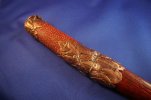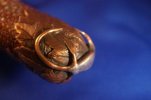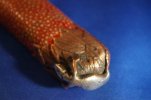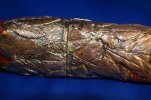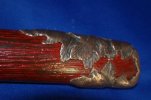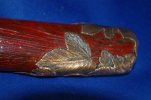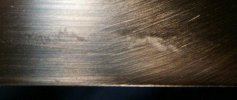Stacy E. Apelt - Bladesmith
ilmarinen - MODERATOR
Moderator
Knifemaker / Craftsman / Service Provider
- Joined
- Aug 20, 2004
- Messages
- 37,974
At the Harrisonburg show, I did a trade for a large batch of Ron Frazier's unfinished stuff.
My friend, Don, arranged the trade, which included several of Frazier's damascus blades that were un-handled, two swords, ivory blocks, a big Randall Bowie, and several other knives. All were being finished or re-worked when Ron fell ill several years ago.
Ron Frazier was a fantastic maker who was first a sculptor and carver, then a knife maker. He was well known for his elaborate handles with small animals on them. Ron is old and very ill ,and sadly, will pass on soon. He has not done any work in a long time.
Among the box full of things I got was a Japanese sword he had started to restore. My friend said he liked it, but had no idea how to fix it. I told him that I would restore it and give it to him. It at first glance looked un-promising, and of little value. It was a wakizashi, clearly quite old, with the blade in fair to poor polish and the saya being somewhat unusual. It was mu-mei, and the nakago had been shortened at some past time. It had been re-handled several times,too ( multiple ana). Ron had started to build fittings of an unusual nature, which I thought I might replace or modify.
After some togi, I discovered that the blade was probably from a very old sword that had been shortened into a wakizashi by shortening from the nakago. The yasurimei was quite nice, and the rust and patina had been preserved well. Off course, I left the nakago as it was. The blade , after some clean up, showed a very nice hamon, and the appropriate amount of age marks. I took it to a cleaned polish, but did not totally restore the surface, as there was no way to know how much skin was left on the blade.
My assessment was that the blade was probably about 400 years old. I can't say exactly why I came up with this age, but the feeling is that it is quite old and has many stories to tell. I wish the mei was still there, as it would have made the value soar, as well as told the age.
The tsuka was plain same' with a red lacquer coating that had been sanded down to produce a red/white handle. The tsuka was of a different wood than the saya, but both appeared to be very old. Ron had shortened the tsuka, and had re-shaped the blade end ( of the tsuka) to accomodate the fittings he had started. The saya was some sort of wood with a very weathered grain that looked like barn wood, with high and low places following the grain. It appeared to be black lacquer with red lacquer over it, and then sanded down to make a two-tone stripe caused by the topographical surface.
There were no original koshirae, and Ron was making fancy fittings in shibuichi, all done in the form of oak and sassafras leaves. He had nearly finished a kashira that had a lizard on it, and a kojiri that was leaves wrapped around the end of the saya.
He had barely started a fuchi and koiguchi that mated in such a way that the leaves flowed from one to the other. He was making it as one piece, with the intention of cutting it in half after the engraving was done to make the two parts. I decided to honor his artistic work and finish the parts he had started. I continued to add leaves to fill the areas that he still had uncovered, engraved all the parts, and then separated the fuchi/koiguchi and added end plates to make the two caps. After cutting the blade and habaki slots, I patinaed all parts. They came out silvery-black, which I rubbed down into an antiqued copper and black finish.
The saya was almost in two pieces ,as most of the rice glue had long ago come apart. Upon disassembly, I discovered that the wood was some type of black and brown species similar to black palm. The raised black grain areas were hard and the soft brown areas was abraded down to make the high/low contrast. The red lacquer thus filled the low areas and sealed the brown wood, exposing the shiny and hard black grain. I left it as it was, and fitted the koshirae to it.
The final result is a really unusual sword.I feel the value is between $2000 and $4000.
I'll post on the other sword as I get more done on it. It may be the big winner from the box.
My friend, Don, arranged the trade, which included several of Frazier's damascus blades that were un-handled, two swords, ivory blocks, a big Randall Bowie, and several other knives. All were being finished or re-worked when Ron fell ill several years ago.
Ron Frazier was a fantastic maker who was first a sculptor and carver, then a knife maker. He was well known for his elaborate handles with small animals on them. Ron is old and very ill ,and sadly, will pass on soon. He has not done any work in a long time.
Among the box full of things I got was a Japanese sword he had started to restore. My friend said he liked it, but had no idea how to fix it. I told him that I would restore it and give it to him. It at first glance looked un-promising, and of little value. It was a wakizashi, clearly quite old, with the blade in fair to poor polish and the saya being somewhat unusual. It was mu-mei, and the nakago had been shortened at some past time. It had been re-handled several times,too ( multiple ana). Ron had started to build fittings of an unusual nature, which I thought I might replace or modify.
After some togi, I discovered that the blade was probably from a very old sword that had been shortened into a wakizashi by shortening from the nakago. The yasurimei was quite nice, and the rust and patina had been preserved well. Off course, I left the nakago as it was. The blade , after some clean up, showed a very nice hamon, and the appropriate amount of age marks. I took it to a cleaned polish, but did not totally restore the surface, as there was no way to know how much skin was left on the blade.
My assessment was that the blade was probably about 400 years old. I can't say exactly why I came up with this age, but the feeling is that it is quite old and has many stories to tell. I wish the mei was still there, as it would have made the value soar, as well as told the age.
The tsuka was plain same' with a red lacquer coating that had been sanded down to produce a red/white handle. The tsuka was of a different wood than the saya, but both appeared to be very old. Ron had shortened the tsuka, and had re-shaped the blade end ( of the tsuka) to accomodate the fittings he had started. The saya was some sort of wood with a very weathered grain that looked like barn wood, with high and low places following the grain. It appeared to be black lacquer with red lacquer over it, and then sanded down to make a two-tone stripe caused by the topographical surface.
There were no original koshirae, and Ron was making fancy fittings in shibuichi, all done in the form of oak and sassafras leaves. He had nearly finished a kashira that had a lizard on it, and a kojiri that was leaves wrapped around the end of the saya.
He had barely started a fuchi and koiguchi that mated in such a way that the leaves flowed from one to the other. He was making it as one piece, with the intention of cutting it in half after the engraving was done to make the two parts. I decided to honor his artistic work and finish the parts he had started. I continued to add leaves to fill the areas that he still had uncovered, engraved all the parts, and then separated the fuchi/koiguchi and added end plates to make the two caps. After cutting the blade and habaki slots, I patinaed all parts. They came out silvery-black, which I rubbed down into an antiqued copper and black finish.
The saya was almost in two pieces ,as most of the rice glue had long ago come apart. Upon disassembly, I discovered that the wood was some type of black and brown species similar to black palm. The raised black grain areas were hard and the soft brown areas was abraded down to make the high/low contrast. The red lacquer thus filled the low areas and sealed the brown wood, exposing the shiny and hard black grain. I left it as it was, and fitted the koshirae to it.
The final result is a really unusual sword.I feel the value is between $2000 and $4000.
I'll post on the other sword as I get more done on it. It may be the big winner from the box.
Attachments
Last edited:

